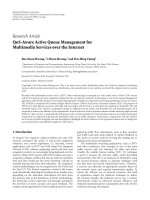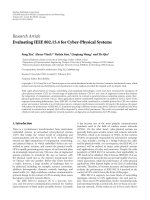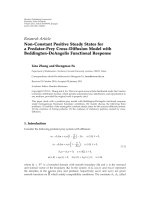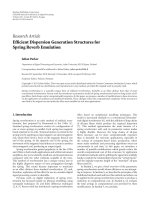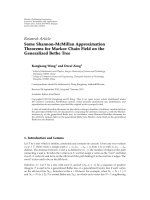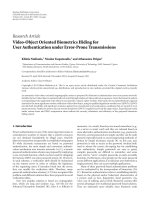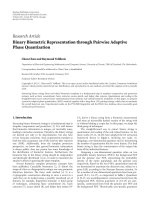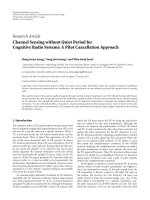Báo cáo hóa học: " Research Article Channel Sensing without Quiet Period for Cognitive Radio Systems: A Pilot Cancellation Approach" ppt
Bạn đang xem bản rút gọn của tài liệu. Xem và tải ngay bản đầy đủ của tài liệu tại đây (665.27 KB, 7 trang )
Hindawi Publishing Corporation
EURASIP Journal on Wireless Communications and Networking
Volume 2011, Article ID 650619, 7 pages
doi:10.1155/2011/650619
Research Ar ticle
Channel Sensing without Quiet Period for
Cognitive Radio Systems: A Pilot Cancellation Approach
Dong Geun Jeong,
1
Sang Soo Jeong,
2
and Wha Sook Jeon
2
1
Department of Electronics Engineering, Hankuk University of Foreign Studies, Yongin-si, Kyonggido 449-791, Republic of Korea
2
School of Electrical Engineering and Computer Science, Seoul National University, Seoul 151-742, Republic of Korea
Correspondence should be addressed to Dong Geun Jeong,
Received 16 July 2010; Revised 8 December 2010; Accepted 17 January 2011
Academic Editor: Ashish Pandharipande
Copyright © 2011 Dong Geun Jeong et al. This is an open access article distributed under the Creative Commons Attribution
License, which permits unrestricted use, distribution, and reproduction in any medium, provided the original work is properly
cited.
The cognitive radio (CR) systems usually arrange for the quiet period to detect the primary user (PU) effectively. Since all CR users
do not transmit any data during quiet period, the interference caused by other CR users can be prevented in the channel sensing
for PU detection. Even though the quiet period improves the PU detection performance, it degrades the channel utilization of
CR system. To cope with this problem, we propose a channel sensing scheme without quiet period, which is based on the pilot
cancellation, and analyze its performance. The numerical results show that the proposed scheme highly outperforms the existing
PU detection schemes.
1. Introduction
The cognitive radio (CR) system exploits the spectrum band
that is originally assigned to licensed primary users (PUs) but
not used at a specific time and a specific location. When a
PU is activated newly, the CR system should move out the
spectrum band. Thus, to detect the appearance of a PU is
one of the most important tasks in CR systems. To detect
PU without interference from CR users themselves, the CR
system usually has “quiet period,” during which all CR users
do not access the channel [1–3]. However, the use of quiet
period degrades the channel utilization of the CR system
and also deteriorates the quality of service (QoS) of the CR
users [3]. If the CR system performs PU detection when the
system is idle (i.e., it has no traffic to be transmitted), the
performance degradation can be mitigated. However, since
the CR system should detect PU within a given time after its
appearance [1], the “regular” channel sensing is unavoidable
even when the system is busy.
To maintain high utilization of channel in PU detection
essentially, the PU detection schemes without quiet period
have been proposed recently. In [4, 5], we have proposed a
nonquiet PU detection scheme for the orthogonal frequency
division multiple access-(OFDMA-) based CR system, with
which the CR users detect the PU by using the subcarriers
that are utilized for the data transmission. Although the
scheme can improve the performance of both CR system
and PU, it only considers the data subcarriers and does not
exploit the pilot subcarriers for the PU detection. In [6],
the PU detection scheme exploiting complementary symbol
couple (CSC) in pilot signal has been proposed. When the
sum of two adjacent pilot symbols of CR system is zero,
they satisfy the complementary condition. If two OFDM
symbols satisfying the complementary condition are added,
the pilot interference becomes zero whereas the noise and
the PU signal still remain. Thus, PU detection without quiet
period can simply be accomplished. However, its detection
performance is limited since only a part of pilot symbols
satisfies the complementary condition.
In this paper, we propose a novel nonquiet PU detection
scheme which is based on pilot cancellation (see Figure 1).
Since the information content of the pilot signal from the
CR transmitter is known a priori to all other CR users in
the system, the receiver (i.e., the detector) CR users can
easily remove it from the received signal (e.g., [7]). If the
pilot signal is transmitted via a specific channel(s) (e.g.,
the pilot subcarriers in OFDM systems) and the CR users
check the existence of PU on the channel(s) after the pilot
2 EURASIP Journal on Wireless Communications and Networking
PU
CR user
(detector)
Received PU signal
s(t)
Received pilot signal
i(t)
CR transmitter
CR system
Figure 1: PU detection without quiet period.
cancellation, they can accomplish PU detection without
quiet period. Although the proposed concept can be applied
to any CR systems using pilot signal on a specific channel,
for the purpose of convenient description, we in this paper
consider only the OFDMA-based CR system such as IEEE
802.22 [1], where some subcarriers are dedicated to the
pilot signal. In contrast to the scheme in [6], the proposed
scheme can exploit all OFDM symbols of pilot subcarriers
for PU detection. Therefore, the CR users can achieve better
detection performance with the proposed scheme.
Even though the concept of pilot cancellation is not
new and well known, its application to the PU detection
in CR system is a novel approach. Moreover, the proposed
scheme improves the CR system performance not from the
detection-theoretical aspect but from the system le vel resource
manage ment aspect. In practice, the latter is more important.
The remainder of this paper is organized as follows. Section 2
describes the system model under consideration. The pro-
posed scheme is presented in Section 3,andatheoretical
analysis for its performance is given in Section 4. Section 5
discusses the performance of the proposed scheme with
some numerical examples from theoretical analysis and
simulation. Finally, the paper is concluded with Section 6.
2. System Model
We con si de r an OF DM A-b as ed C R s ys tem . T he sp ec tr um
band of the CR system is fragmented into multiple subcar-
riers that are equally spaced. Among them, M subcarriers
are used for transmitting pilot sequence which is known
to all CR users. The pilot signal is commonly used for the
channel estimation and the synchronization. The proposed
scheme can be applied to both the system with a single
CR transmitter (e.g., downlink of a CR cell) and that with
multiple CR transmitters (e.g., uplink of a CR cell). In
the former case, the single CR transmitter utilizes all pilot
subcarriers; in the latter case, the pilot subcarriers can be
distributed among multiple CR transmitters.
The system under consideration adopts the frame struc-
ture, where the frame length corresponds to L OFDM symbol
durations (see Figure 2). In many existing (non-CR) systems,
“frame” is the time unit corresponding to the source and/or
channel coding block. Thus, the channel measurement
reporting for channel adaptation mechanism (e.g., the power
control and the adaptive modulation and coding) is usually
carried out frame-by-frame basis. If the channel condition
changes largely during a frame, the channel estimation is
likely to be inaccurate, and the system performance can
be severely degraded. To avoid this situation, the frame
length in practical systems is decided so that the channel
variation during a frame is small enough to be neglected.
In this paper, we design the PU detection scheme that
can be implemented into the existing frame-structured
systems. Thus, it is assumed that the channel state for a CR
transmitter-receiver pair does not vary during a frame.
For pilot signal, a total of M
× L OFDM symbols are
transmitted in a frame (see Figure 2). We assume that, in the
case with multiple CR transmitters, each pilot subcarrier is
assigned to a specific CR transmitter for a whole frame. The
frame is the basic time unit of PU detection.
Since there are in-phase and quadrature branches for
each pilot subcarrier, 2M correlators are needed for a CR
receiver to extract all pilot components. Let us index the cor-
relators, respectively, by 1, , M for in-phase components
and M +1, ,2M for quadrature components. Let t is the
time index defined during a frame.Andletφ
m,l
(t)denote
the basis function for the OFDM symbol l (1
≤ l ≤ L)of
mth correlator in a frame. When T
O
is the OFDM symbol
duration, φ
m,l
(t) is as follows [8]:
φ
m,l
(
t
)
:
=
⎧
⎪
⎪
⎪
⎪
⎪
⎨
⎪
⎪
⎪
⎪
⎪
⎩
2
T
O
cos
2π
f
c
+
m
T
O
t
if m = 1, , M,
2
T
O
sin
2π
f
c
+
m
−M
T
O
t
if m = M+1, ,2M,
(1)
where (l
− 1)T
O
≤ t ≤ lT
O
and f
c
is the center frequency
of CR system. Since the pilot signal is a control signal of
vital importance, a modulation technique with high noise
immunity such as the binary phase shift keying (BPSK)
modulation is generally used for transmitting the pilot signal
in practice [2]. We assume a BPSK-modulated pilot signal
in describing the proposed scheme. It is also assumed that
all users in the CR system are synchronized. (Since the
proposed scheme is based on the CR pilot cancellation, its
performance is affected by the synchronization error between
the CR transmitter and the CR receiver (PU detector)
in sensing. However, according to our simulation results,
the performance degradation can be negligible when the
synchronization error is less than the allowable error for the
reliable data transmission (e.g., in [9]).
Let r(t) denote the signal received by a CR user.
Depending on whether the PU signal exists or not, there can
be the following two hypotheses on the pilot subcarriers:
EURASIP Journal on Wireless Communications and Networking 3
Frame (= L OFDM symbol durations) Frame ···
Time
OFDM symbol duration
Frequency band
M pilot subcarriers
···
···
···
···
···
···
···
Figure 2: Frame structure.
(i) PU present hypothesis, H
1
: r(t) = i(t)+n(t)+s(t),
(ii) PU absent hypothesis, H
0
: r(t) = i(t)+n(t),
where i(t), n(t), and s(t) are the received CR pilot signal, the
noise, and the received PU signal, respectively, (see Figure 1).
We assume that n(t) is a white Gaussian noise with two-sided
power spectral density σ
2
N
. It is noted that the received signal
includes the CR pilot signal, in contrast to the case with the
quiet period, since we consider the nonquiet PU detection.
3. Proposed Scheme
3.1. Operation Overview. With the proposed scheme, a CR
user carrying out PU detection first removes the pilot signal
from the signal received on the pilot subcarriers (i.e., i(t)
is removed from r(t)) and then makes a decision on the
existence of PU. This procedure consists of the following
four steps on a per frame basis: (1) sampling: the CR user
collects the received signal samples (i.e., correlator outputs)
during a frame; (2) channel estimation: at the end of the
frame, the CR user estimates the channel coefficient from
the transmitter CR user by using the received signal samples
and the (known) pilot sequence; (3) pilot cancellation: the CR
user removes the pilot interference from the received signal
samples; (4) decision making: the CR user generates the test
statistic and compares it with a threshold in order to decide
thepresenceofaPU.
It is noted that the first two steps are the normal
operations in the system using pilot signals. The last step
is needed for any PU detection scheme. Only the third
step is additionally required for implementing the proposed
scheme, of which complexity is low as described in the next
section.
3.2. PU Detection with Pilot Cancellation. Now, we describe
in detail the proposed channel sensing scheme without quiet
period. Various PU signal detection methods, including the
energy detection, the cyclostationary feature detection [10],
the eigenvalue detection [11], and the correlation matching
approach [12], can exploit the proposed scheme. However,
for the convenient description of the proposed concept
within a limited page length, we only consider the energy
detection herein. (For employing energy detection, the noise
power should be estimated. There can be several estimation
methods. As an example, the estimation can be done when
allCRusersinthesystemhavenotraffictobesent.)
The received signal is passed through the correlators to
generate signal samples. As stated before, the PU detection
is performed at the end of a frame which corresponds to L
OFDM symbol times indexed by 1, 2, , L.Ifr
m,l
denotes
the signal sample from the mth correlator (1
≤ m ≤ 2M)
at OFDM symbol time l (1
≤ l ≤ L),
r
m,l
=
lT
O
(l−1)T
O
r
(
t
)
φ
m,l
(
t
)
dt
= i
m,l
+ u
m,l
,
(2)
where i
m,l
is the in-phase or the quadrature component of
the received CR pilot symbol; u
m,l
= n
m,l
+ s
m,l
under H
1
and
u
m,l
= n
m,l
under H
0
,wheren
m,l
is a zero mean Gaussian
random variable with variance σ
2
N
[8]ands
m,l
is the sampled
value of the PU signal. The statistical property of s
m,l
depends
on the symbol duration, the information bit sequence, and
themodulationtypeofthePUsignal.
For a CR user, (2)canberewrittenasr
m,l
= h
m
· d
m,l
+
u
m,l
,whereh
m
is the channel coefficient which is constant
during a frame and d
m,l
is the deterministic quantity
contributed by both the pilot sequence and the transmission
amplitude which are known to CR users. It is noted that
d
m,l
= d
m−M,l
for M +1 ≤ m ≤ 2M since only the phase-
shifted version of the in-phase component of pilot signal is
received at the quadrature branch with BPSK modulation,
which we assume in this paper.
A CR user can estimate the channel coefficient by
applying the least-squares channel estimation technique to
the received signal samples. When
h
m,l
denotes the estimate
of channel coefficient,
h
m,l
· d
m,l
= h
m
· d
m,l
+ u
m,l
,then,
h
m,l
= h
m
+ u
m,l
/d
m,l
. If there are neither PU signal nor
noise, perfect channel estimation can be achieved (i.e.,
h
m,l
=
h
m
for 1 ≤ l ≤ L). However, due to the effect of PU signal
and noise, the estimate of channel coefficient inevitably has
the uncertainty, u
m,l
/d
m,l
. Since the least-squares estimator
4 EURASIP Journal on Wireless Communications and Networking
for multiple samples is the sample mean estimator [13], the
estimate of channel coefficient for a frame becomes
h
m
=
1
L
L
l=1
h
m,l
= h
m
+
1
L
L
l=1
u
m,l
d
m,l
.
(3)
After the channel estimation is finished, the pilot cancel-
lation is performed for each received signal sample. Let
r
m,l
denote the cancellation result for the mth correlator output
of OFDM symbol l,then,
r
m,l
= r
m,l
−
h
m
·d
m,l
= u
m,l
−d
m,l
·
1
L
L
i=1
u
m,i
d
m,i
,
(4)
where the last term in (4) represents the residual pilot can-
cellation error. (In (4), the strength of the CR pilot signal
contributes equally (on average) to both the denominator
and the numerator of the pilot cancellation error. Therefore,
the pilot signal strength has little effect on the amount of
pilot cancellation error.)
Finally, the “test statistic,” which corresponds to the
energy received during a frame, is generated using the
cancellation results. That is, the test statistic is the squared
sum of 2ML cancellation results
Δ :
=
2M
m=1
L
l=1
r
2
m,l
.
(5)
Then, the resulting test statistic is compared to the threshold
value,
.IfΔ > , the CR user decides that the PU exists.
Otherwise, the CR user regards the spectrum band as empty.
There can be two types of detection errors, respectively,
called the “false alarm” and the “missdetection.” The false
alarm is issued when Δ >
even though the PU is not
activated; the missdetection is the case that Δ <
when
the PU exists actually. These detection errors, respectively,
degrade the performances of CR system and PU and are very
sensitive to the decision threshold.
3.3. Application Remarks. In this paper, we consider the pilot
cancellation for the PU detection without quiet period. The
proposed concept can also be applied to the CR systems
using “frame preamble.” The frame preamble containing
the sequence known to the receiver is originally utilized
for channel estimation and synchronization, as the pilot
does. Since there is no conceptual difference between the
PU detection with the preamble cancellation and that with
the pilot cancellation, we do not treat the detailed procedure
herein.
On the other hand, the proposed scheme can be easily
adopted in the sequential and the cooperative detection
structures. That is, if a CR system has multiple test statistics
that are generated during multiple frames and/or produced
from multiple CR users, the CR system can combine them
by using an appropriate combining technique. In this case,
the detection performance can be improved as the number
of combined test statistics increases. In order to concentrate
upon the main issue (i.e., the nonquiet sensing by using pilot
cancelation), we do not treat the application of the proposed
scheme to the sequential and cooperative detection.
4. Performance Analysis
In this section, we analyze the performance of proposed PU
detection scheme. We adopt the following two assumptions
for simplifying the analysis.
(i) The PU signal sample, s
m,l
, is a zero mean Gaussian
random variable with variance of σ
2
S
[13, 14]. More-
over, PU signal samples are independent with respect
to each other.
(ii) The CR pilot subcarriers always transmit the infor-
mation bit “1”.
It is noted that these assumptions do not hold generally in
practice. Nevertheless, the numerical results of this analysis
well meet with the simulation results obtained without these
assumptions, as will be presented in Section 5,whichshows
the practical usefulness of the analysis herein. We define
the PU signal-to-noise ratio (SNR) as the ratio between the
received signal power from a PU and the noise power. That
is, the PU SNR is σ
2
S
/σ
2
N
.
With the above assumptions,
L
l=1
r
2
m,l
=
L
l=1
⎛
⎝
u
m,l
−
1
L
L
i=1
u
m,i
⎞
⎠
2
=
L
l=1
u
2
m,l
−
1
L
⎛
⎝
L
l=1
u
m,l
⎞
⎠
2
.
(6)
First, let us consider the hypothesis H
1
.Then,u
m,l
is a zero
mean Gaussian random variable with variance of σ
2
S
+ σ
2
N
.
Thus, Θ
m
:= (1/(σ
2
S
+ σ
2
N
))
L
l
=1
u
2
m,l
follows the central chi-
square distribution with L degrees of freedom and Λ
m
:=
(1/(σ
2
S
+σ
2
N
))(1/L)(
L
i
=1
u
m,i
)
2
is a central chi-square random
variable with one degree of freedom.
Let Φ
m
:= (1/(σ
2
S
+ σ
2
N
))
L
l
=1
r
2
m,l
.AndletE[X | H]and
V[X
| H], respectively, denote the mean and variance of a
random variable X under the hypothesis H (
∈{H
0
, H
1
}).
Then,
E
[
Φ
m
| H
1
]
= L −1, (7)
V
[
Φ
m
| H
1
]
= E
(
Θ
m
−Λ
m
)
2
| H
1
−
(
E
[
Φ
m
| H
1
])
2
= E
Θ
2
m
| H
1
−
2E
[
Θ
m
·Λ
m
| H
1
]
+ E
Λ
2
m
| H
1
−
(
L
−1
)
2
.
(8)
By using the fact that the fourth moment of u
m,l
is 3(σ
2
S
+
σ
2
N
)
2
, one can easily verify that E[Θ
m
· Λ
m
| H
1
] = L +2.
Therefore, V[Φ
m
| H
1
] = 2(L −1).
EURASIP Journal on Wireless Communications and Networking 5
According to the definitions of Δ and Φ
m
, Δ =
2M
m
=1
(σ
2
S
+
σ
2
N
)Φ
m
.Thus,Δ can be viewed as a sum of independent and
identically distributed random variables. When 2M is a large
number, according to central limit theorem,
Δ
∼ N
2M
(
L−1
)
σ
2
S
+σ
2
N
,4M
(
L−1
)
σ
2
S
+σ
2
N
2
under H
1
,
(9)
where N [μ,σ
2
] denotes a Gaussian distribution with mean
of μ and variance of σ
2
and “∼” means “is distributed as.”
With a similar procedure, the distribution of the test statistic
under H
0
can be derived as follows:
Δ
∼ N
2M
(
L −1
)
σ
2
N
,4M
(
L −1
)
σ
4
N
under H
0
.
(10)
Let q
FA
and q
MD
denote, respectively, the false alarm and
the missdetection probabilities, when PU detection is carried
out just once (i.e., for one-time decision on PU existence).
Most existing studies focus only on these performance mea-
sures. However, we consider some additional measures that
represent the performance of CR systems more effectively in
practice.
The detection delay is defined as the time from the
appearance of a PU to its successful detection. Since the
detecting decision is made every frame, the detection delay
increases as q
MD
becomes high. In the practical CR systems
(e.g., IEEE 802.22 WRAN), one of the system requirements
is to detect PU appearance within a time limit (i.e., a
required detection delay), with the probability higher than
a given value. Let us denote this time limit by T
limit
.The
final missdetection probability for a CR user is defined as
the probability that, when a PU is activated, the CR user
cannot detect the presence of the PU within T
limit
.Thefinal
false alarm probability is defined as the probability that at
least one false alarm is issued during T
limit
. Let us denote
the final false alarm and the final missdetection probabilities
by P
FA
and P
MD
, respectively. In general, not from the
detection-theoretical point of view but from the system-
wide point of view, the detection delay, the final false alarm
probability, and the final missdetection probability are more
practical performance measures than the false alarm and the
missdetection probabilities for one-time PU detection.
The system requirements on the PU detection perfor-
mance can be given by T
limit
and the target P
FA
(or the target
P
MD
). In this paper, we consider the system adopting the
target P
FA
as system requirement. For the given T
limit
and P
FA
,
the target q
FA
is calculated as follows:
q
FA
= 1 −
(
1
−P
FA
)
1/T
limit
/(L·T
O
)
.
(11)
Then, based on the distribution of test statistic (10), a CR
user can determine the decision threshold value
for one-
time PU detection as follows.
= 2M
(
L −1
)
σ
2
N
Q
−1
q
FA
M
(
L −1
)
+1
, (12)
where Q
−1
(·)isaninverseQ-function.
We now compute q
MD
when this threshold value is used.
Let us assume that a PU is activated at the beginning of an
OFDM symbol which is randomly selected within a frame.
When a PU is activated at OFDM symbol l in a frame (1
≤
l ≤ L), a CR user receives PU signal only during (L − l +1)
OFDM symbol times. Thus, q
MD
under this condition can be
expressed as
q
MD
(
l
)
= 1 −Q
⎛
⎝
M
(
L −1
)
×
⎛
⎝
2M
(
L −1
)
((
L
−l +1
)
/L
)
σ
2
S
+ σ
2
N
−
1
⎞
⎠
⎞
⎠
.
(13)
Using q
MD
(l), we have the final missdetection probability
P
MD
:
P
MD
=
1
L
L
l=1
q
MD
(
l
)
q
MD
(
1
)
n(l)
,
(14)
where n(l)
=(T
limit
− (L − l +1)T
O
)/(L · T
O
).Notethat
n(l) + 1 corresponds to the number of PU detection trials
within T
limit
.
During the PU detection delay, the CR system may inter-
fere with the PU irrespective of whether or not the delay
exceeds T
limit
. Therefore, we use the mean detection delay D,
as another performance measure
D
=
T
O
L
L
l=1
⎛
⎝
1 −q
MD
(
l
)
(
L
−l +1
)
+ q
MD
(
l
)
∞
i=1
q
MD
(
1
)
i−1
1 −q
MD
(
1
)
×
(
L
−l +1+iL
)
⎞
⎠
.
(15)
5. Numerical Results
We examine the PU and the CR systems with parameter
values listed in Ta b l e 1 , which are based on IEEE 802.22
WRAN specifications [1]. It is noted that the last five
parameter values in Ta b l e 1 are for simulation only. Unless
noted otherwise, the target P
FA
is set to 0.01. In this section,
we present not only the numerical results from the above
analysis but also those from simulation. To generate the
pilot signal in simulation, the long pseudonoise sequence
in [1] is used. As a PU, we consider the analog TV system
transmitting the random data by using the vestigial sideband
(VSB) modulation. We have also conducted the simulation
when PU is a wireless microphone using the frequency
modulation (FM), of which bandwidth is 200 kHz. Since the
results are almost the same as those with an analog TV for
the given PU SNR, we do not include them herein.
First, we investigate the performance of the proposed
scheme according to the PU SNR, when L
= 10. In
6 EURASIP Journal on Wireless Communications and Networking
0.01
0.1
1
Mean detection delay (s)
Mean detection delay
−18 −17 −16 −15 −14
−13
PU SNR (dB)
0
0.1
0.2
0.3
0.4
0.5
0.6
0.7
0.8
Final missdetection probability
Miss detection
probability
Theoretical
Simulation
Figure 3: Performance of the proposed scheme according to PU
SNR.
Table 1: Parameter values for performance evaluation.
Parameter Value
Number of pilot subcarriers, M 240
OFDM symbol duration (msec), T
O
0.341
Required detection delay (msec), T
limit
100
Number of subcarriers 2048
Bandwidth of CR system (MHz) 6
Center frequency of CR system (MHz) 500
Bandwidth of PU (MHz) 6
Center frequency of PU (MHz) 500
Figure 3, it is clear that the PU with stronger signal can be
more easily detected by the CR user. Figure 3 also shows
that the simulated and the theoretical results well match
with each other. This indicates that the theoretical analysis
in Section 4 is accurate although it is derived under the
simplified assumptions for the PU signal and the pilot
sequence. From now on, we present only the theoretical
results for the proposed scheme.
Next,wecomparetheperformanceoftheproposed
scheme with those of the PU detection scheme adopting
quiet period and the PU detection scheme exploiting CSC
[6]. The performance results for these two schemes are
obtained by using simulation. In simulation, the scheme with
quiet period performs the energy detection for the entire
band of the CR system during one OFDM symbol time per
frame. The scheme with CSC exploits the complementary
OFDM symbols transmitted by the pilot subcarriers on
frame-basis, to detect the presence of PU. As for the proposed
scheme, the detection delay, the final false alarm probability,
and the final missdetection probability are obtained by
carrying out the PU detection during multiple frames, for
the schemes with quiet period and with CSC.
Figure 4 shows the final missdetection probability ac-
cording to the final false alarm probability when the PU SNR
is
−14 dB. In the figure, the performance of the detection
with CSC is poorer than that of the proposed scheme
1E−3
0.01
0.1
1
Final missdetection probability
1E−30.01
0.1
Final false alarm probability
Proposed; L
= 10
Proposed; L
= 20
Detection with QP; L
= 10
Detection with QP; L
= 20
Detection with CSC; L
= 10
Detection with CSC; L
= 20
Figure 4: Miss detection probability according to false alarm
probability (QP: quiet period).
0
0.2
0.4
0.6
0.8
1
Maximum utilization of CR system
Mean detection delay
5 1015202530
Frame length, L (in OFDM symbol durations)
0
0.02
0.04
0.06
0.08
0.1
0.12
0.14
Mean detection delay (sec)
Utilization
Proposed
Detection with QP
Detection with CSC
Figure 5: Maximum utilization of CR system and mean detection
delay according to L (QP: quiet period).
for the same L.ThisisbecauseonlyapartofOFDM
symbols transmitted by pilot subcarriers satisfy the required
complementary condition. From the figure, we can see
that the missdetection probability of the proposed scheme
decreases as L increases. This results from the fact that more
samples can be involved in one-time PU detection with a
larger number of OFDM symbols in a frame. However, since
the number of frames (thus, the number of PU detection
trials) within T
limit
is reduced as L increases, the marginal
decrease in the final missdetection probability becomes very
small when L
≥ 20. Figure 4 also shows that the detection
performance of the proposed scheme is better than that of
the scheme with quiet period if L is not less than 10.
Figure 5 shows the maximum utilization of CR system
and the mean detection delay according to L, when the PU
EURASIP Journal on Wireless Communications and Networking 7
SNR is
−12 dB. It is clear that the proposed scheme and
the scheme with CSC can always achieve the utilization
of 1.0 since they are nonquiet detection schemes, whereas
that of the scheme with quiet period is less than 1.0.
Moreover, the mean detection delay of the proposed scheme
is much less than that of the scheme with CSC. Therefore,
we can conclude that the proposed scheme can greatly
increase the system utilization while accomplishing the better
detection performance in comparison to other schemes.
(The operating value of L is larger than 20 in usual, when
considering the simulation parameters in Ta b l e 1 .) Figure 5
also shows that, as L increases, the mean detection delay
of the proposed scheme decreases first and then slightly
increases. This is because the mean detection delay is affected
by not only the frame length but also the missdetection
probability of one-time PU detection.
6. Conclusion
We have suggested an efficient PU detection scheme for CR
systems, which performs the nonquiet channel sensing by
using the pilot cancellation technique. The theoretical anal-
ysis and simulation results show that the proposed scheme
can detect the PU effectively while improving the utilization
of the CR system significantly. Since the complexity of the
proposed scheme is very low, specifically for the CR systems
already utilizing pilot subchannels, it has the practical merit
in implementation. In this paper, we have demonstrated the
performance of the proposed scheme only when the energy
detection is applied. If more complex but efficient detection
scheme (e.g., cyclostationary feature detection) is used, the
performance will be further improved.
Acknowledgments
The authors are grateful to the anonymous reviewers and the
editor for their valuable comments. This work was supported
in part by the Korea Research Foundation Grant funded
by the Korean Government (KRF-2008-314-D00274) and
in part by the Korea Science and Engineering Foundation
(KOSEF) Grant funded by the Korean Government (MEST)
(no. R01-2008-000-21098-0).
References
[1] IEEE P802.22/D0.3.7, “Draft Standard for Wireless Regional
Area Networks Part 22: Cognitive Wireless RAN Medium
Access Control (MAC) and Physical Layer (PHY) specifica-
tions: Policies and procedures for operation in the TV Bands,”
July 2007.
[2]Y.C.Liang,Y.Zeng,E.Peh,andA.T.Hoang,“Sensing-
throughput tradeoff for cognitive radio networks,” in Proceed-
ings of the IEEE International Conference on Communications
(ICC ’07), pp. 5330–5335, Glasgow, UK, June 2007.
[3] W. S. Jeon, D. G. Jeong, J. A. Han, G. Ko, and M. S. Song, “An
efficient quiet period management scheme for cognitive radio
systems,” IEEE Transactions on Wireless Communications,vol.
7, no. 2, pp. 505–509, 2008.
[4]S.S.Jeong,W.S.Jeon,andD.G.Jeong,“Dynamicchan-
nel sensing management for OFDMA-based cognitive radio
systems,” in Proceedings of the IEEE Vehicular Technology
Conference (VTC ’07), Dublin, Ireland, April 2007.
[5]S.S.Jeong,D.G.Jeong,andW.S.Jeon,“Nonquietprimary
user detection for OFDMA-based cognitive radio systems,”
IEEE Transactions on Wireless Communications,vol.8,no.10,
pp. 5112–5123, 2009.
[6] D. Chen, J. Li, and J. Ma, “In-band sensing without quiet
period in cognitive radio,” in Proceedings of the IEEE Wireless
Communications and Networking Conference (WCNC ’08),pp.
723–728, Las Vegas, Nev, USA, April 2008.
[7] S. Moshavi, D. Yellin, J. S. Sadowsky, Y. Perets, and K. Pick,
“Pilot interference cancellation technology for CDMA cellular
networks,” IEEE Transactions on Vehicular Technology, vol. 54,
no. 5, pp. 1781–1792, 2005.
[8] S. Haykin, Communication Systems, John Wiley & Sons, New
York, NY, USA, 4th edition, 2001.
[9]J.I.MontojoandL.B.Milstein,“Effects of imperfections
on the performance of OFDM systems,” IEEE Transactions on
Communications, vol. 57, no. 7, pp. 2060–2070, 2009.
[10] W. A. Gardner, “Exploitation of spectral redundancy in
cyclostationary signals,” IEEE Signal Processing Magazine,vol.
8, no. 2, pp. 14–36, 1991.
[11] Y. Zeng and Y. C. Liang, “Maximum-minimum eigenvalue
detection for cognitive radio,” in Proceedings of the 18th
Annual IEEE International Symposium on Personal, Indoor and
Mobile Radio Communications (PIMRC ’07), Athens, Greece,
September 2007.
[12] A. I. P
´
erez-Neira, M. A. Lagunas, M. A. Rojas, and P. Stoica,
“Correlation matching approach for spectrum sensing in
open spectrum communications,” IEEE Transactions on Signal
Processing, vol. 57, no. 12, pp. 4823–4836, 2009.
[13] S. M. Kay, Fundamentlas of Statistical Signal Processing:
Estimation Theory, Prentice Hall, New York, NY, USA, 1993.
[14] E. G. Larsson and G. Regnoli, “Primary system detection
for cognitive radio: does small-scale fading help?” IEEE
Communications Letters, vol. 11, no. 10, pp. 799–801, 2007.

